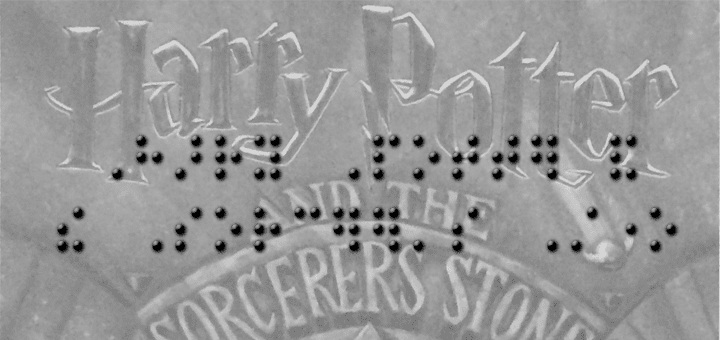 Harry Potter and the Braille Unification
Harry Potter and the Braille Unification
In the taxonomy of publications I have developed to capture all the linguistically interesting (print) editions of the Harry Potter books, there is one little used category: “transliteration”.
Whereas “translation” is rendering text from one language into another, “transliteration” is rendering text from one script into another—the language stays the same. For example, the title of the Japanese Philosopher’s Stone:
| Title: | ハリー・ポッターと賢者の石 |
| [language: Japanese; script: Han + Hiragana + Katakana] | |
| Transliteration: | harī pottā to kenja no ishi |
| [language: Japanese; script: Latin] | |
| Translation: | Harry Potter and the Philosopher’s Stone |
| [language: English; script Latin] |
Usually, transliteration is used like above—to give naive readers something remotely recognizable; it’s relatively rare to find publications in more than one script. Generally, languages tend to stick to one writing system, but it is certainly not unheard of. In some of the countries of the former Soviet Union, for instance, the native languages have variously been written in Arabic, Cyrillic and Latin. Arabic first because historically, they were Muslim countries; Cyrillic after the USSR took over education and lately Latin as they try to distance themselves from their Soviet past.
When it comes to “The List“, we need transliteration as a category to capture Serbian which was published in both Latin and Cyrillic (another artefact of Soviet influence) and also Braille, the tactile script used by the visually impaired. There are other cases where transliteration would have been possible on the list, but new translations were completed instead (think Mandarin) undoubtedly due to issues of political identity. (Are you catching that a lot of script choices come down to politics?)
Braille is unique in that regard—it isn’t political, it’s a writing system in a different modality that makes the written word accessible to specific demographic within a community of speakers—it’s a whole fascinating rabbit-hole in its own right, cognitively, sociologically, typographically… But let’s stay focused on Harry Potter publications.
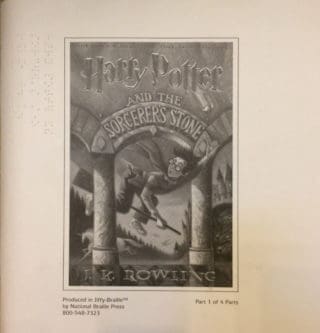
Back when I acquired my English Braille Philosopher’s Stone (omgh a decade ago? really?), there was only one edition available. I never really revisited Braille after that—that actually may have been a subconscious defense strategy, but more on that later. That changed recently when another collector approached me to identify a couple of Braille books he had. There have been some major changes in the English Braille-reading world in the last decade and there are now four—that’s right four—different US English Braille transliterations available.
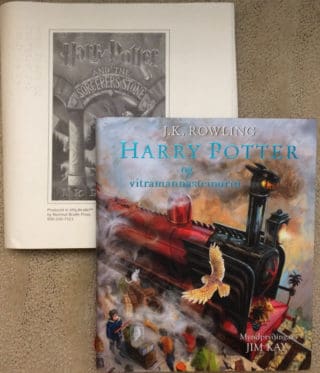
It’s a bit of a collector’s nightmare. If you haven’t seen Braille text—it’s really big and the books are even bigger. My Braille Philosopher’s Stone is approximately the same physical size as the Jim Kay (regular) illustrated Philosopher’s Stone—except it comes in four volumes, so four illustrated Philosopher’s Stones. And of those four available transliterations, mine is the most space efficient—the least would probably be at least two more volumes. Six volumes. And I’m not sure if you’ve noticed, but Philosopher’s Stone is the shortest of them… They don’t actually provide all the numbers, but I’d estimate that the least space-efficient Braille Order of the Phoenix would probably be about twenty volumes. So, let’s ballpark it: if, as a collector I wanted to get all seven books in all four variations, I’d be looking at around 275 illustrated Philosopher’s Stones weighing more than 500lbs and costing nearly $5000US.
Yeah, so…
Let’s back up and ask why there are now four English Braille transliterations.
Uncontracted and Contracted Braille
Braille just about universally (by which I mean, across languages) comes in two flavours: “uncontracted” and “contracted”. Traditionally, in English these have been called “Grade 1” and “Grade 2” Braille, but that is one of the changes that has happened in the last few years. “Grades 1 & 2” have caused a lot confusion so the more accurate and descriptive “contracted” and “uncontracted” have been adopted. Basically, “uncontracted” means that there is basically a one-to-one correspondence between the Latin and Braille text-every letter is spelled out in Braille.
Consider that Braille is read with the finger tips though—the effective speed at which an individual can absorb information through that modality is simply slower than vision. So in order to make things more efficient, a standard set of contractions have been introduced to represent frequent letter combinations and words: “contracted” Braille. In general, text in contracted Braille seems to be about two-thirds the length of text in uncontracted Braille; a pretty huge savings! However, becoming a fluent Braille reader takes time; especially children and people just learning Braille can’t read the contractions and so many publications are available in both.
Unified English Braille (UEB)
This is the big change that has happened recently. For a number of reasons, there has been an international push to fix some problems in English Braille. Some of those reasons are technical—as the computer transliteration of Latin to Braille has become more prevalent, some of the contraction conventions have been problematic because they can be ambiguous. Eliminating those ambiguities makes automated transliteration far easier. Other reasons are due to regional variations between English speaking countries that make it more difficult for readers to access materials from different countries.
Basically, Braille has undergone spelling reform—and everyone, at least the organizations that establish standards, have decided to adopt it. Of course, people don’t like change. And to be fair there is a learning curve with spelling reform: imajin trayiŋ to ri:d a mor fonetik Iŋgliʃ buk. Its nat so: i:zi: e:? The previous American standard was English Braille American Edition (EBAE) and the new standard is Unified English Braille (UEB).
Of course, just like the original Braille standard, UEB comes in contracted and uncontracted forms—and now you know why Harry Potter is available in four American English Braille editions (in order of a most to least space efficient):
EBAE Contracted
UEB Contracted
EBAE Uncontracted
UEB Uncontracted
You might well ask if UEB was about disambiguating contractions, are the uncontracted versions actually different then? And the answer is, “yes”—the letters are not, but UEB also includes some changes to other conventions like punctuation. So although they would be very very similar, they are still different.
Wait… English Braille American Edition?
Yes Virginia, there is also at least one UK English Braille Harry Potter set. I haven’t gotten very far in researching them, but they do exist and I could cry.
Wait… English Braille?
Yes—blind people exist in every culture, so it should come as no surprise that pretty much every language that Harry Potter has been translated into has a Braille transliteration. Now, that doesn’t actually mean that they all have every Harry Potter book in Braille. It’s exceedingly difficult to find details particularly searching in English. Looking for other Braille transliterations in languages aside from English has crossed my mind several times. Fleetingly. Here’s where my subconscious defenses start to kick in… let’s ballpark it again.
I’m only interested in collecting Philosopher’s Stone, so let’s only consider the first book. And let’s say I’m only interested in contracted Braille. And let’s say that Braille publications are only available in about 25% of the translations. And let’s say that all of those are, like my English, four volumes. We’re still talking about another 80 illustrated Philosopher’s Stones! In terms of physical volume, it’s like 3-4 times my current collection! I cannot go down that road even though my collector’s OCD is twinging that they fall into the parameters of how I define my collection.
This is why I’ve started directing my collector’s OCD towards The List… much cheaper and takes up way less space!
I couldn’t resist getting the eBraille version from the National Blind Press though, so for your edification, Page 1 of Chapter 1 of the contracted UEB Sorcerer’s Stone:
⠠⠠⠮⠀⠠⠠⠃⠕⠽⠀⠠⠠⠱⠕⠀⠠⠠⠇⠊⠧⠫
⠠⠏⠗⠊⠧⠑⠞⠀⠠⠙⠗⠊⠧⠑⠂⠀⠶⠀⠏⠗⠳⠙⠀⠖⠎⠁⠽⠀⠞⠀⠮⠽⠀⠶
⠏⠻⠋⠑⠉⠞⠇⠽⠀⠝⠕⠗⠍⠁⠇⠂⠀⠹⠁⠝⠅⠀⠽⠀⠧⠀⠍⠡⠲⠀⠠⠮⠽⠀⠶⠀⠮
⠇⠁⠌⠀⠏⠀⠽⠄⠙⠀⠑⠭⠏⠑⠉⠞⠀⠖⠃⠑⠀⠔⠧⠕⠇⠧⠫⠀⠔⠀⠁⠝⠽⠹⠬
⠌⠗⠁⠝⠛⠑⠀⠕⠗⠀⠍⠽⠌⠻⠊⠳⠎⠂⠀⠆⠉⠀⠮⠽⠀⠚⠀⠙⠊⠙⠝⠄⠞⠀⠓⠕⠇⠙
⠾⠀⠎⠡⠀⠝⠕⠝⠎⠢⠎⠑⠲
⠀⠀⠠⠍⠗⠲⠀⠠⠙⠥⠗⠎⠇⠑⠽⠀⠴⠀⠮⠀⠙⠊⠗⠑⠉⠞⠕⠗⠀⠷⠁⠀⠋⠊⠗⠍
⠉⠁⠇⠇⠫⠀⠠⠛⠗⠥⠝⠝⠬⠎⠂⠀⠱⠀⠍⠁⠙⠑⠀⠙⠗⠊⠇⠇⠎⠲⠀⠠⠓⠑⠀⠴⠀⠁
⠃⠊⠛⠂⠀⠃⠑⠑⠋⠽⠀⠍⠁⠝⠀⠾⠀⠓⠜⠙⠇⠽⠀⠁⠝⠽⠀⠝⠑⠉⠅⠂⠀⠁⠇⠹
⠓⠑⠀⠙⠊⠙⠀⠓⠀⠁⠀⠧⠀⠇⠜⠛⠑⠀⠍⠥⠌⠁⠡⠑⠲⠀⠠⠍⠗⠎⠲
⠠⠙⠥⠗⠎⠇⠑⠽⠀⠴⠀⠹⠔⠀⠯⠀⠃⠇⠕⠝⠙⠑⠀⠯⠀⠸⠓⠀⠝⠑⠜⠇⠽
⠞⠺⠊⠉⠑⠀⠮⠀⠥⠎⠥⠁⠇⠀⠁⠍⠨⠞⠀⠷⠀⠝⠑⠉⠅⠂⠀⠱⠀⠉⠁⠍⠑⠀⠔⠀⠧
⠥⠎⠑⠰⠇⠀⠵⠀⠩⠑⠀⠎⠏⠢⠞⠀⠎⠀⠍⠡⠀⠷⠀⠓⠻⠀⠐⠞⠀⠉⠗⠁⠝⠬⠀⠕⠧⠻
⠛⠜⠙⠢⠀⠋⠰⠑⠎⠂⠀⠎⠏⠽⠬⠀⠕⠝⠀⠮⠀⠝⠑⠊⠣⠃⠕⠗⠎⠲⠀⠠⠮
⠠⠙⠥⠗⠎⠇⠑⠽⠎⠀⠸⠓⠀⠁⠀⠎⠍⠁⠇⠇⠀⠎⠕⠝⠀⠉⠁⠇⠇⠫⠀⠠⠙⠥⠙⠇⠑⠽
⠯⠀⠔⠀⠸⠮⠀⠕⠏⠔⠊⠕⠝⠀⠐⠮⠀⠴⠀⠝⠕⠀⠋⠔⠻⠀⠃⠕⠽⠀⠁⠝⠽⠐⠱⠲
⠀⠀⠠⠮⠀⠠⠙⠥⠗⠎⠇⠑⠽⠎⠀⠸⠓⠀⠐⠑⠽⠹⠬⠀⠮⠽⠀⠺⠁⠝⠞⠫⠂⠀⠃⠀⠮⠽
⠁⠇⠀⠸⠓⠀⠁⠀⠎⠑⠉⠗⠑⠞⠂⠀⠯⠀⠸⠮⠀⠛⠗⠞⠑⠌⠀⠋⠑⠜⠀⠴⠀⠞
⠐⠎⠃⠕⠙⠽⠀⠺⠙⠀⠲⠉⠕⠧⠻⠀⠭⠲⠀⠠⠮⠽⠀⠙⠊⠙⠝⠄⠞⠀⠹⠔⠅⠀⠮⠽
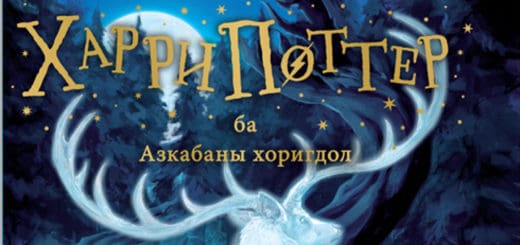
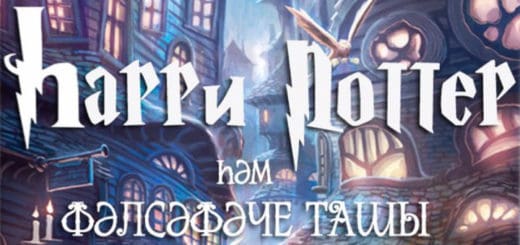
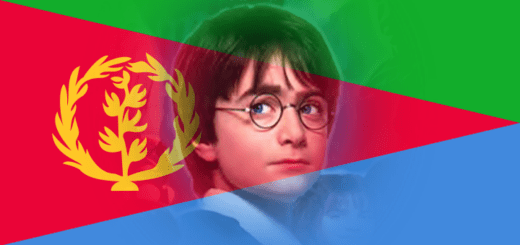

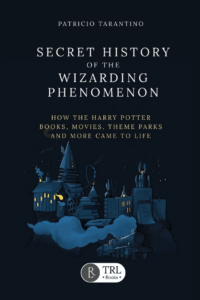


Great article! Funnily enough the UK braille were the first ‘translations’ I even bought – from living 5 mins walk from where they are all printed! They’re super cheap too because they’re subsidised here – I felt too bad buying all the PS volumes for just £4 printed in front of me, so bought old first prints of the 2nd and 3rd braille books for more & ended up sending one to a blind friend I met in Shetland! It’s awesome they exist.
That’s so cool! Do you still have your first PS? I’d love to see pictures! Do you remember the name of the place you got yours? So far the only place I found them online is Royal Blind and I’m just curious if it’s the same place. 🙂 Price seems about right! I was pretty shocked by that and emailed them to confirm that it was in fact a print version! That’s the way it should be though… I can’t imagine having to pay so much for just novels! And eBraille seems like a fantastic solution (and it is!) but I was curious about the displays and even those run $3K~$15KUS! I’m sure it’s worth it and I’m sure there are programs to help out people that can’t afford them, but it seems like a big burden to normalize really basic access…
I gifted the old CoS, so have the PS (this one was the one I got printed new this year), and the old prisoner of Azkaban first printing now but can still show you pictures if you like!
All items for the blind are shipped free in to any address in the UK too. How much are they in the US?
Yeah that’s crazy!
I can send you my copy of PS to look at if you’d like to compare. It’s 5 volumes versus the Jiffy braille 4 volumes and super tall. Just let me know.